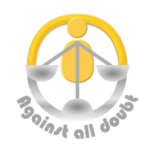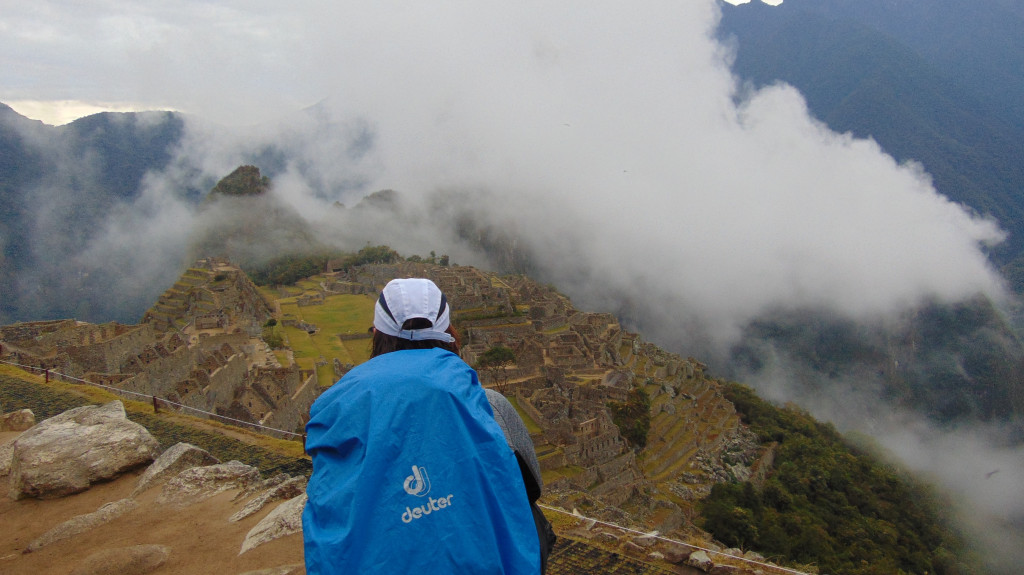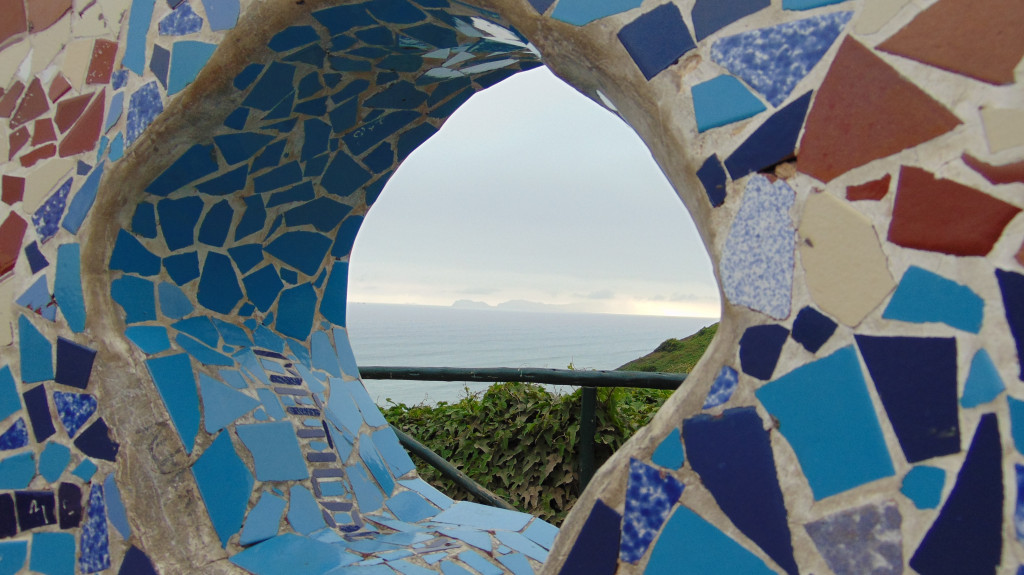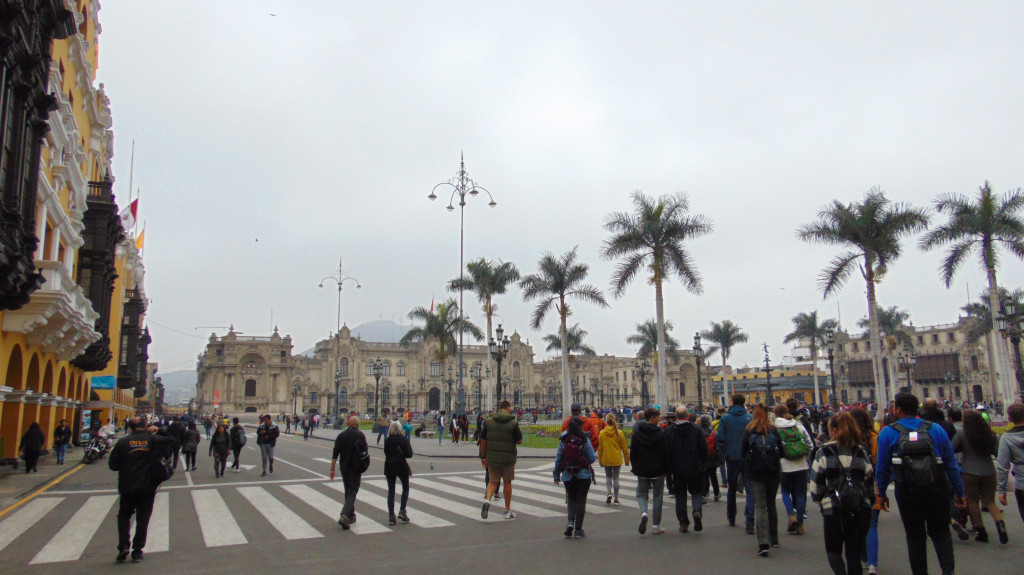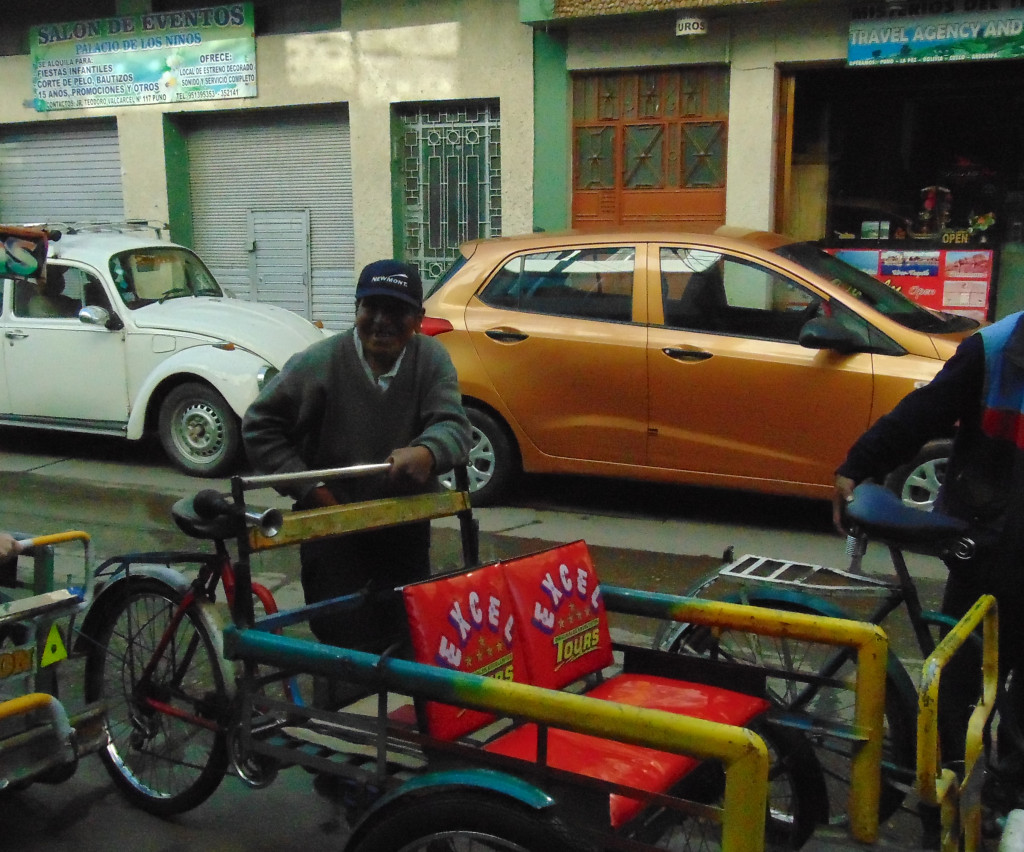Lima
Yeah finally it is time to travel!
This time it is Lima via Amsterdam.
After a short connection, a 12 hour flight and a good night sleep I took the day to explore Lima.
I took a free waking tour starting at the Kennedy Park in Mariflores, where I met two nice ladies from Spain and Greece.
Going by public transportation to the old city of Lima where we saw the first bank of Peru, founded by an Italian as well as the first Colonial Street. At the Placa de Armas we watched the exchange of the guards in front of the presidential palace.
Also we visited a Dominican church and the smallest church of the world – la “Capilla Nuestra Seniora del Rosario”.
The library which used to be a train station and an orphanage brought to Lima by the Asians made one of the last spots we went to.
Also an interesting bit of information- the Inka name for Peru means the children of the sun.
After a nice lunch of ceviche we went back to Mariflores to walk along the malecon towards “La parque de amor”.
We visited a small version of the Christ the Redeemer Statue, which was bought be the government with a donation of Muslims. The were allowed and supported to work here while they fled a war at home. Out of gratitude they donated some money.
The next stop is an old Inca Temple called “Saqsazwaman”. This has two meanings
- Satisfied bird
- Temple of Lightning
Satisfied bird because it was one of the last battlefields between the Inca and the Spanish and Temple of Lightning because of the form.
It was partly destroyed to build up the chapel of the main plaza of Cusco.
Time for culture!
I started the morning with coca tea and a good breakfast. Then I took the stairs up Qorikancha – the Temple of the sun. Today it is a Dominican Convent, with a museum. A lot of the old Inka stones are still there. Like the Rainbow Chamber, the Lightning Chamber or the Moon Chamber.
Also it has a huge garden.
In the Milky Way Painting you can also the a Llama, a hunter, a fox, a partridge, a toad and a serpent- can you see them?
The animals are sacred for the people in the Andes because they heralded the comin of rain.
Walking the city of Cusco you will find a lot of churches, 15 in total. And there is a tradition here that you have walk to all the churches following a certain route. Here are some of them- I did not do the whole one.
This Arc was actually donated to the people of Cusco after the civil war with Chile. For one of the last fights the Bolivians, who were supporting Peu, never showed up. To make up for it the send the arc.
At noon we went on to a cooking class. Starting with a visit to San Pedro Market. We tried different kind of fruits and good some stuff for the class.
Back in the school we started with a Pisco Sour followed by a Qinoa Salad and Lomo Saltado. The chef had already prepared our dessert- black corn ice cream. The class was a wonderful experience with nice company and really good food!
Ollantaytambo
Today we took the bus to Ollantaytambo. On the way there we passed the Qenqo Tempel (Tempel of the frog), Wayarcocha, Puca Pucara (Red Fortress), Ccoru, visited a Weaving site, a pottery and drove through the Sacred Valley we had lunch in Pisac where we played Sapo.
Under the stones of the Qengo Tempel the Incas had an altar where they sacrificed black lamas. Black because of the milky way (see picture yesterday) shows a black lama.
In Wayarcocha we saw the little bulls on top of the houses. You can find this tradition throughout Peru. When a couple marries the get the bulls as a present. It is a good luck charm for the family.
The Puca Pucara was the fortress overlooking all three valleys and therefore a checkpoint for all the people coming from the jungle.
Ccorau is 3,600m above sea-level and therefore they can only grow potatoes here, which causes malnutrition problems, but they start building up greenhouses now. An interesting fact is that there are 3,500 versions of potato in Peru. That means you can eat a different sort of potato for 9 and a half years!
The Inka Trail
Starting at km 104 of the trail that originally started in the Inka capital Cusco. Originally used for trading there where a lot of places on the trail to do sacrifices for save travels like corn or black Llamas. Both for the spirit and soul. All of them where abandoned in 1536 when also Machu Picchu was abandoned.

Trail length 10km, starting at 2,150m altitude up to 2,750m altitude at the Sun Gate with a lot of steps going up and down on the way.
Beautiful Landscapes along the trail including a waterfall.
After reaching Winaywayna it was time for our lunch break at the campsite of the 4 day hike.
Now of to the second half of the trip up the monkey steps to Intipunku (sun gate).
Here I was able to get the first glimpse of Machu Picchu waiting every so often for the clouds to clear.
Walking down towards the bus station we got the chance to see Machu Picchu completely without people.
But it seemed we spend to much time there since the gates were already closed to get out.
Machu Picchu
First some history. There was a civilization before the Incas called Caral, which was concerned by the Incas not by war, but by talking to them.
The known history of the Incas starts only with the 8th King in1438 when the Incas started their expansion starting form Cusco. That is also when Machu Picchu was build. It was used for about 100 years and about 700 people lived here.
When th Spanish arrived the Incas went down very quickly because of two reasons. First they had never seen big man wit beards and thought the Lord has come to them and second the Spanish brought a disease with them that killed a lot of people. In 1536 Machu Picchu was abandoned.
What we can see now is what has been discovered in 1911 by Hiram Bingham.
And now enjoy the views!
Rainbow Mountain

Montana Winikunka- known as Rainbow Mountain because it is so colorful is 5,036m high. The colors are due to the oxidation of minerals in the mountain. The red color comes from Iron, the green from Copper and yellow from Sulfate. These are still in the rocks since this is the only that is left of the former glacier.
Going into the valley we could also see the highest glacier, Ausangate, in Cusco with 6,380m.
Since it had snowed during the night we had the chance to see it in white…

…and in colorful.

Hiking in this altitude was a whole new experience for me and it was so worth it!
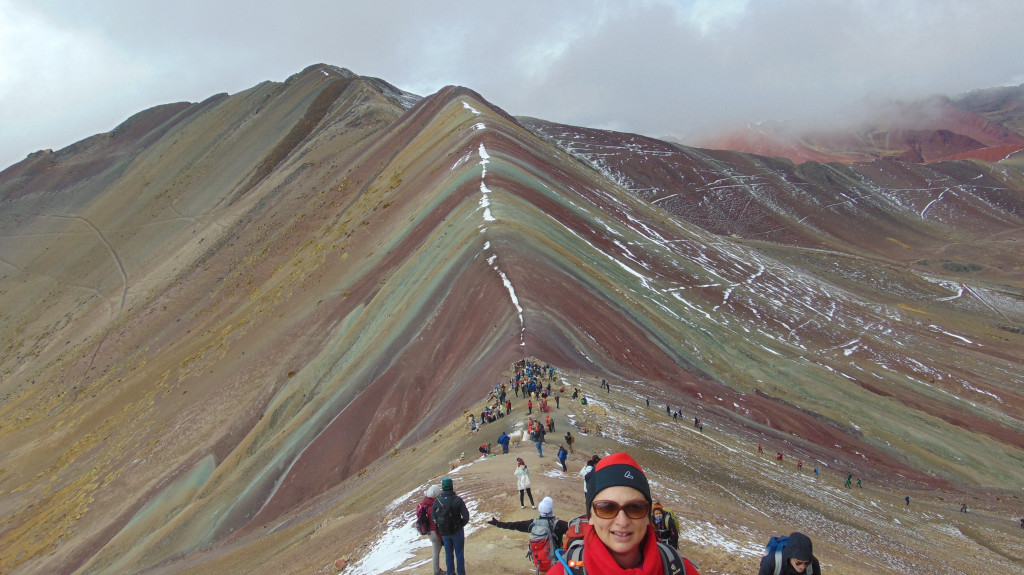
Lake Titicaca
First we went with Peruvian limousines to the harbor to get on our boat for the day. The lake Titicaca has about 8,560 km² and is the highest negotiable lake.
In the Puno area there are 150 floating islands. One of them Suma Kurmi is our first stop.
There are 7 families, with 20 people living on it.
There we are told how the islands are build and that it needs about 2 years for one island.
After the floating islands we boat deeper into Lake Titicaca to Isla Taquile. This is a solid island and we have lunch with a wonderful view here.
To see a little bit more of the island we hike across it and find a dance competition in the main square of the island.
What you need to know to travel in Peru- high mountains low valleys
- For the ladies- always have one Soles for the bathrooms ready and if they are for free you mostly will need your own paper.
- Even if it is nice and sunny out- take your jacket it still can get cold quickly.
- Even if it is cloudy out- use your sunscreen. You are high up and likely to burn without.
- Dress in layers, because the weather can change quickly from T-shirt to Winter jacket.
- If you feel the altitude drink Coca Tea, it really helps.
- Coming back from higher altitude drink Munja Tea, this will help against the dizziness.
What you always wanted to know about online Life Coaching
There are many reasons why I chose to offer my services online.
Here are the three most important ones:
- In addition to all the daily tasks, I wanted to save you from having to drive to a life coach
- You should feel as comfortable as possible during our sessions.
- Professional and private travels should not get in the way of our conversations.
To these good reasons I now add Corona. In my work at the children’s and youth telephone it becomes clear to me again and again, that just now such an offer is very important.
In 1973, Freudenberger created the term burn-out in the United States. At that time, he described the burn-out of people in caring or social professions. Today, burn-out is no longer seen only in social professions. According to a study by Statista from 2017 with 649 respondents, it emerges that in the service sector most respondents (14%) estimate the risk of burn-out to be the highest. With 11%, health, care and social services are still the second most affected group. In the area of administration, management and office work, 9% of the respondents still estimate their risk as high.
You will find what I experienced and how it made me the person I am now. Because in every challenge there is also something to learn about yourself. The biggest and ongoing learning is to be yourself- against all doubt from yourself and others.
Also, you get some free input about methods I use during the Life Coaching and how they worked for me. Not every method will work for you too, but I am sure together we can find something that works for you!
Read more of my learnings
